Boeing (BA 0.39%) suffered a brutal one-two punch over the past two years: The 737 MAX grounding and the COVID-19 pandemic together caused it to burn tens of billions of dollars of cash while eroding its order backlog.
While Boeing expects to continue burning cash throughout 2021, it has started to stabilize its 737 MAX backlog, with plenty of help from two key customers: Southwest Airlines (LUV 1.19%) and Ryanair (RYAAY 1.37%). Moreover, both airlines have indicated that they will probably order even more 737 MAX jets before too long.
Additional orders from these two low-cost titans would certainly be helpful. However, Boeing needs many more 737 MAX orders from a much broader base of airline customers to get the 737 program back to health.

Image source: Ryanair.
Two big orders to stabilize the 737 MAX program
At the beginning of 2019, Boeing had over 4,700 firm orders for the 737 family. By the end of 2020, that figure had fallen to 3,282 (including Boeing's allowance for orders that are likely to be canceled sooner or later).
The backlog shrank almost continuously during 2020 -- even in December, when Boeing captured an order for 75 additional 737 MAX 200s from Ryanair. Still, without the Ryanair deal, the backlog would have eroded even more.
So far, 2021 has been similar to the end of 2020. Boeing logged 255 gross orders for 737s in the first four months of this year. However, its net orders for the 737 family (after cancellations and conversions) totaled a mere 24 units, while the company delivered 67 737s over the same period. As a result, its 737 backlog shrank from 3,282 units to 3,239 units. Without Southwest Airlines' March order for 100 additional 737 MAX 7s, Boeing would have a negative net order total year to date.
Looking to buy more
Southwest Airlines ended April with 334 outstanding firm orders for the 737 MAX. However, those orders are spread over 10-plus years. More than a third won't be delivered until 2029 or thereafter!

Image source: Southwest Airlines.
The bulk of these existing orders will cover Southwest Airlines' aircraft replacement needs over the next decade. Fortunately for Boeing, Southwest CEO Gary Kelly recently estimated that the carrier has an opportunity to expand its fleet by hundreds of aircraft in the long run. It's quite conceivable that Southwest will ultimately exercise all 270 of its 737 MAX options to seize that opportunity.
Meanwhile, Ryanair expects to take delivery of all 210 737 MAX jets it has ordered by the summer of 2025. Most of those planes will be growth aircraft, allowing the budget carrier to expand its fleet from 470 aircraft in early 2020 to around 600 by 2025.
While Ryanair has a very young fleet -- and thus modest fleet replacement needs over the next decade -- it will undoubtedly keep growing in the second half of the 2020s. Sure enough, CEO Michael O'Leary reiterated last month that Ryanair hopes to place an order for at least 100 737 MAX 10s by year-end, with deliveries beginning around 2026.
No panacea for Boeing
Given their growth ambitions, Southwest Airlines and Ryanair will inevitably place follow-up 737 MAX orders sooner or later. But what really matters is how fast they can take delivery of new jets.

Image source: Boeing.
Ryanair's fleet plan calls for 50-60 annual deliveries over the next few years, a pace that could be sustainable based on its substantial market share opportunities. Southwest could plausibly take about 60 jets annually (on average) over the next decade -- double the pace its current firm order book calls for.
If Southwest and Ryanair together take 120 737s annually, that would fill 10 delivery slots per month. Between the roughly 2,700 outstanding 737 orders from other customers, Boeing should be able to find takers for the other 32 monthly slots that would be available based on the 42-per-month production rate that it hopes to achieve by late 2022.
On the other hand, Boeing probably couldn't sustain a faster 737 production rate without a big uptick in orders from customers other than Southwest and Ryanair. The current backlog is propped up by speculative orders from aircraft leasing companies and huge orders from a handful of Asian airlines that have clearly over-ordered. Moreover, Boeing's recent order activity has been dominated by just a few customers; most airlines are still retrenching.
In effect, this means that Boeing needs additional orders from Southwest Airlines and Ryanair just to sustain a 737 production rate of 42 per month. Boeing would need a flood of orders from other airlines to justify a return to the higher production rates it achieved a few years ago. Without a broader revival of demand for the 737 MAX, Boeing will continue to struggle for the foreseeable future.





